Yves here. Welcome Satyajit Das as he continues his in-depth examination of what it would take to reach a much-ballyhooed green energy future. Many of you were keen about his first offering in this series last week.
By Satyajit Das, a former banker and author of numerous works on derivatives and several general titles: Traders, Guns & Money: Knowns and Unknowns in the Dazzling World of Derivatives (2006 and 2010), Extreme Money: The Masters of the Universe and the Cult of Risk (2011), A Banquet of Consequences RELOADED (2021) and Fortune’s Fool: Australia’s Choices (2022)
Abundant and cheap power is one of the foundations of modern civilisation and economies. Energy Destinies is a multi-part series examining changes in energy markets, perhaps the most significant for a long time, and their implications. The first part looked at the part played by power in the rise of modern societies and patterns of demand and supply over time. This part looks at the renewable energy sources, specifically the potential for solar and winds plants to replace fossil fuels
Nothing New Under The Sun
The search for alternative energy sources is not new. Historically, it has revolved around:
- Availability – nations lacking large reserves of fossil fuels have sought to offset this weakness including dependence on suppliers or transport routes.
- Cost – users of energy have focused on lower cost fuel sources.
- Scientific developments – improvements in energy physics and chemistry have encouraged use of alternatives.
Over the last three decades, the search for alternatives has been motivated by the desire to reduce fossil fuel emissions. This is particularly the case in advanced nations once cleaner burning fuels like natural gas and oil derivatives emerged alleviating obvious aspects of air pollution. But it will also need to overcome shortages from dwindling fossil fuel supplies.
Types of Alternative Energy Sources
Alternatives can be grouped into:
- Nuclear – there was increasing interest in nuclear energy after World War 2 as a sources of baseload electricity due to its scale and promise of electricity “too cheap to meter”. It was attractive especially to countries lacking large low cost fossil fuel reserves such as Japan, France and Germany.
- Hydro – flowing water is a historically important source of energy (water mills). Dams, promoted by developmental agencies like the World Bank, combined power generation, irrigation, flood control and transportation links (effectively as a bridge). Indian Prime Minister Jawaharlal Nehru proclaimed the dams as the ‘temples of modern India’ integrating agricultural development and the village economy with rapid industrialisation and growth of the urban economy.
- Modern Renewables –primarily to solar and wind.
Nuclear energy fell from favour after major incidents (Three-Mile Island; Chernobyl; Fukashima), widespread public opposition and concern about proliferation of nuclear weapons. Ecological damage and displacement of populations has reduced the allure of dams over the years although existing hydro-technology, because of its long life, is likely to continue to remain an energy source. It will also become increasingly important for power storage.
The current focus is renewable energy, derived from natural sources, replenished at a higher rate than they are consumed and creating lower emissions than fossil fuels. It is a mixture of old and new technologies.
Traditional forms of renewable energy based on mature technology include:
- Hydro – the uses of the energy of water moving from higher to lower elevations to generate electricity through turbines.
- Geo-thermal – the use of thermal energy from the Earth’s interior using wells or other means to generate electricity or provide heating. It is only available in locations with accessible (close to the surface), naturally sufficiently hot and permeable hydrothermal reservoirs.
- Bio-mass– bioenergy is produced from organic materials, primarily wood, and agricultural crops, in the form of liquid biofuels. Modern biomass systems include dedicated crops or trees, residues from agriculture and forestry, and various organic waste streams.
These traditional sources are increasingly supplemented by more recent technology, including:
- Solar – the sun’s radiation is converted into electrical energy either through photovoltaic panels or through mirrors that concentrate solar radiation. Although not all countries are equally endowed, solar energy intercepted by the Earth is about 10,000 times greater than the rate of current consumption making it a very substantial resource.
- Wind – movement of air has been used for millennia to power industry (wind mills) or transport (sailing ships). The modern iteration harnesses the kinetic energy using large wind turbines located on land (onshore) or in seas near the shoreline (offshore). Technological advances (taller turbines and larger rotor diameters) allow increasing the electricity generation potential. While availability of wind energy is variable (average wind speeds vary by location), the theoretical technical potential for wind energy exceeds current global electricity production.
- Ocean energy – the kinetic and thermal energy of sea or fresh water – waves, tidal flows or currents – can generate electricity similar to hydro energy. While the technique is nascent, the theoretical potential for ocean energy may exceed present human energy requirements.
A number of other emergent renewable energy technologies are theoretically feasible:
- Passive daytime radiative cooling – this uses the coldness of outer space for daytime cooling of indoor space cooling, outdoor urban heat island mitigation, and improving solar cell efficiency.
- Earth infra-red thermal radiation – this seeks to convert the flow of infra-red thermal radiation towards cold outer space into electricity. In theory, this technology could be used during night time when solar energy is not being generated.
- Algae fuels – this uses oil or fat rich algae to produce bio-fuels.
- Water vapor – this uses static electricity charges from water droplets on metal to generate power.
Hydrogen is sometimes incorrectly cited as a renewable energy sources. It is a potential store of energy which can be used like oil or gas. It requires energy generated from fossil fuels or renewable sources to power an electrolyser to convert water into hydrogen gas. The odourless, colourless and lightweight zero-carbon gas which can then be stored, transported and used when needed.
The capacity of renewable energy sources to substantially replace fossil fuels is affected by certain features. Although there is some disagreement amongst experts, renewables score low on Energy Return on Energy Invested (EROEI). There are other issues such as intermittency, co-location, energy density, and surface power density. Even the exaggerated focus on the lower carbon dioxide emissions of renewables is not as incontestable as often presented. These factors together with externalities affect the utility and economic cost of renewables.
Intermittency
Ideally, energy availability is immediately available as well as supply being stable and uninterrupted.
Demand, especially for electricity, is often split into layers such as:
- Baseload – relatively constant and consistent minimum demand.
- Peak load –maximum demand, either during a period such as a day or under unusual circumstances, such as an unusually hot day when everyone turns their air conditioners on.
Patterns of required availability vary. Demand overall is increasing and peaks are more difficult to forecast and accentuated, sometimes lasting for longer periods due, in part, to the effects of extreme weather. Peak loads can, in some cases, be double the baseload.
US hourly electricity generation shows the variability.
The energy system requires significant buffer capacity to supply peak needs. A typical current power stack and sources of electricity generation is summarised below:
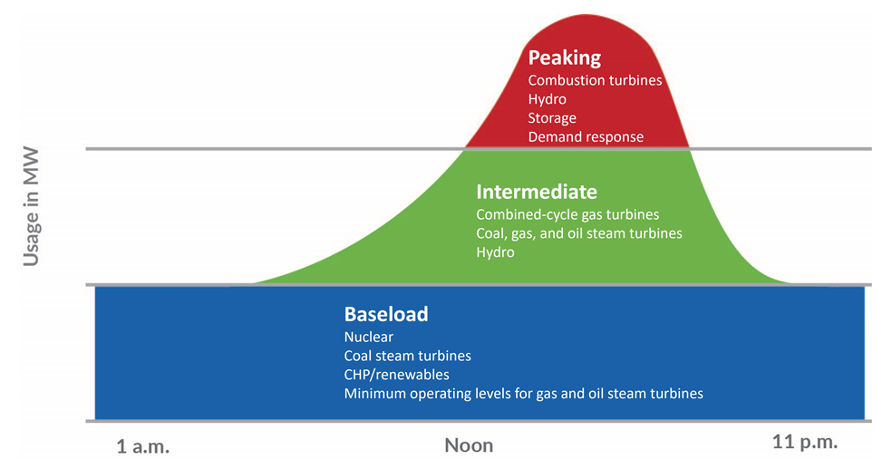
In essence, the need is for immediate availability (often termed dispatchable power); for example, being able to turn on lights, climate control, machinery and access immediate transport options (via traditional fuelled internal combustion engine driven vehicles). Lack of unexpected interruptions and stability is critical for industrial applications which frequently require lengthy start-up and shut down procedures.
A well-documented problem with renewables is intermittency. This takes two forms:
- Predictable intermittency – this relates to natural day-night or seasonal cycles which affect solar, wind, hydro and tidal power generation.
- Unpredictable intermittency – this relates to unanticipated events such as unseasonal weather, i.e. cloud cover, low or high wind or lack of rainfall.
Unpredictable intermittency is particularly challenging. Examples include the phenomenon of global stilling or wind drought. The strength of the wind blowing across northern Europe has fallen by as much as 15 per cent on average, probably due to changes in weather patterns.
Intermittency is a hurdle as modern society and economies are not structured around to continuous, reliable supply. Power cuts would affect transport through failure of electrically powered mass transit systems and even traffic lights. Households require constant uninterrupted supply; e.g. failure of refrigeration due to power cuts would lead to food spoiling and high rise living would become difficult where the risk of being trapped in an elevator was non-trivial.
The problem may be under–estimated. Fluctuations in wind speed have a major effect on performance. If the wind speed drops by half from the ideal 30 kilometres (20 miles) per hour, then the power available falls by a factor of eight. If the wind speed doubles, then the power delivered goes up eight times, and the turbine has to be turned to avoid failure. Installed nominal generating capacity in the European Union and UK in 2021 was 236 gigawatts, but the highest daily output was only 103 gigawatts. The unreliability is greater for the wind generated offshore power.
At a minimum, intermittency requires large scale energy storage or supplementary mechanisms, including fossil fuel or nuclear power generation, to meet the need for dispatchable power.
Infrastructure Requirements
A source of energy close to the point of use is helpful. Coal, gas and nuclear plants can be located conveniently near consumers. Fossil fuels (coal) and liquids (oil, gas) can be transported in bulk or via pipelines. Long distance transport of gas where pipelines are impractical requires expensive dedicated facilities for liquification and regasification as well as specialised ships (known as ‘trains’). Nuclear fuel is easily transportable although security and radiation risks must be managed.
In contrast, many renewable energy sources are geography specific, often long distances from population and industrial centres. The best solar sources are in hotter regions with minimal tree and cloud cover, such as desert or arid regions. The best locations for wind power, such as offshore, are often remote.
This necessitates investment in storage, longer transmission lines and significant re-configuration of the grid adding to cost and infrastructure needs.
A prime problem is the scale required. In part, this reflects the fact that electricity supplied through the grid is historically only one of several ways to access energy. Other options, such as petrol and gas, by-passed the grid. The shift to using more electricity, implied by renewables, requires large scale expansion.
The electricity grid is currently built around generators located near the point of use. Fuel sources are transported to plants and power is distributed to users typically within a compact area. The use of renewables alters these arrangements:
- The energy may be generated some distance from where it is needed requiring new transmission systems.
- Energy storage is needed to manage supply intermittencies.
- In some settings, users also become suppliers of energy (surplus power from homes, agricultural and industrial businesses) requiring changes to the grid from one-way to two-way or one-to-many to many-to-many. In a system with large scale storage, capability to access stored electricity as well as store surplus grid power using the same transmission connection is required.
- Where multiple sources of energy are used, grid management must be adjusted. In fairness, this problem is present albeit in different forms within existing electricity system.
- There may be issues with consistency of the high power quality needed to ensure stability and efficiency, reliability and costs of the network. Problems include frequency disorder, voltage/current harmonics, low power factor, voltage variation, grid inertia, torque distortion (for wind power) and transmission lines transits.
Trans-country or even trans-continental grids using ultra high voltage may be needed to accommodate a high level of renewables. Existing systems which employ alternating current (AC) become less efficient with distance. At higher voltages required to push the current further, AC employs (and thus wastes) an ever-increasing amount of energy in the task of squeezing its alternations through the line. Over transcontinental distances, direct current (DC) is superior meaning major potential revision of the grid structure, perhaps using ultra-high-voltage direct-current (UHVDC) connectors, which are more stable.
The time, expenditure and co-ordination needed to create the infrastructure for a shift to more renewable sources is underestimated. According to the US Department of Energy, the country will need 47,300 gigawatt-miles of new power lines by 2035 to accommodate additional renewable energy capacity, amounting to a 57 percent expansion of the existing grid, as well substantial infrastructure upgrades. The world may need to double the length of transmission lines in operation to 152 million kilometres (90 million miles) to achieve net zero emissions by 2050.
The expenditure needed is substantial. In 2020, the cost of building the millions of miles of new transmission lines and associated infrastructure to accommodate the increase in wind and solar sites was estimated at $14 trillion over the 30-year period between 2020 and 2050. As of 2023, this had risen to $21 trillion. Capital investment in gridsglobally fell between 2017 to 2020 only recovering to 2016 levels ($330 billion) in 2022. Global annual investment in power grids, energy storage and related facilities will need to hit almost $550 billion a year by 2030. Much of this cost will be passed on to energy consumers.
The EV charging points that green consumers fret about are merely a tiny part of the infrastructure problems ahead.
Energy Density
Energy density measures the amount of energy stored in a given system, substance, or region of space. It is usually stated in energy per mass or volume. High energy density equates to a greater the amount of energy stored per unit of mass or volume. It is especially important for applications such as transportation.
There are different estimates of comparative energy densities of different energy sources. Energy densities can be stated in units of joules per cubic meter.
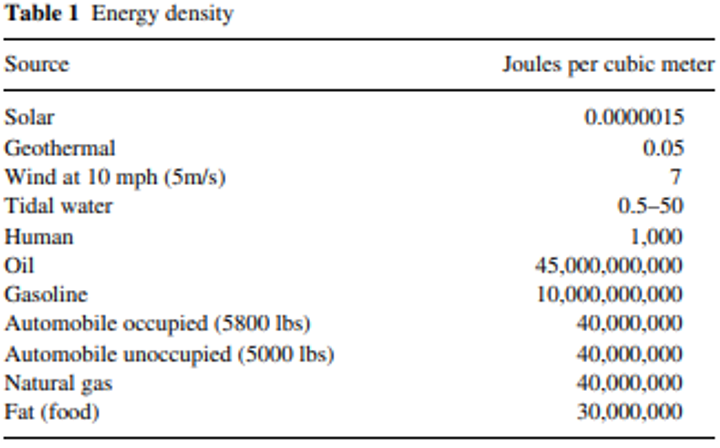
This implies that 3.8 litres (1 gallon) of gasoline contains approximately forty megajoules of chemical energy which divided by volume yields an energy density of ten billion joules per cubic meter. Gasoline is ten quadrillion times more energy-dense than solar radiation and one billion times more energy-dense than wind and water power.
Energy density for a variety of common fuels by weight (megajoules per kilogram) is set out below.
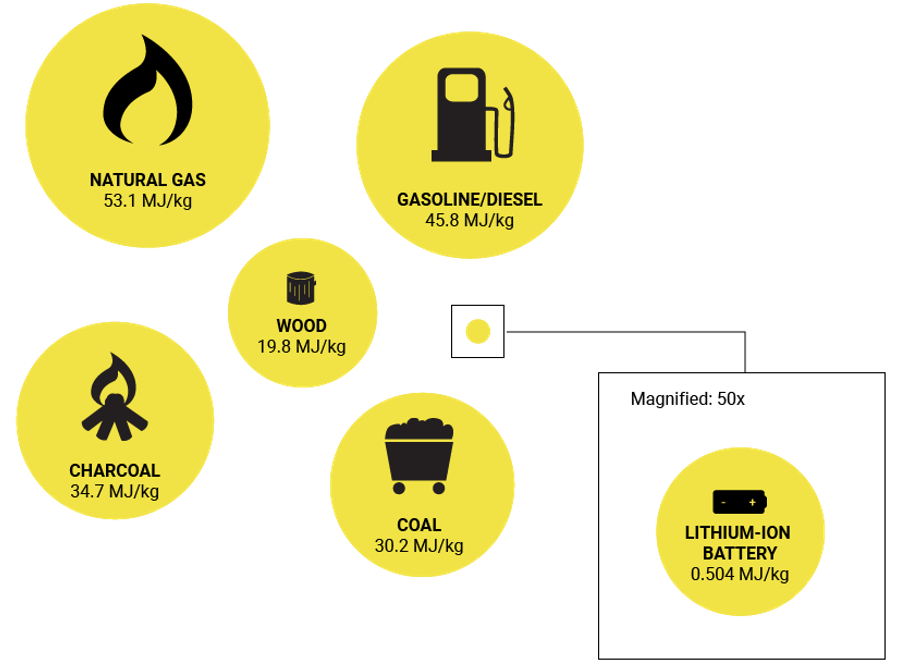
Energy density calculations should be treated with caution. It is commonly cited that Uranium235 (used in nuclear energy) can produce 83,140,000 megajoules per kilogram. This would make it nearly 3 million and 2 million times more energy rich than coal and oil respectively. This is misleading. The uranium fuel used for power generation is at low levels of purity (around 4%). It must be burned in batch process at a slow pace to avoid explosive energy release (as in atomic weapons). Significant energy, relative to other energy sources, is expended to separate and enrich it from ore where it occurs at low levels of concentration. This reduces its energy density substantially although it is still several times more powerful than fossil fuels.
In summary, fossil fuels and nuclear power display notably higher energy density, meaning that less fuel is needed to produce the required power which is important for certain applications.
The energy density measured by weight and volume of several common transportation power sources exhibits significant variation.
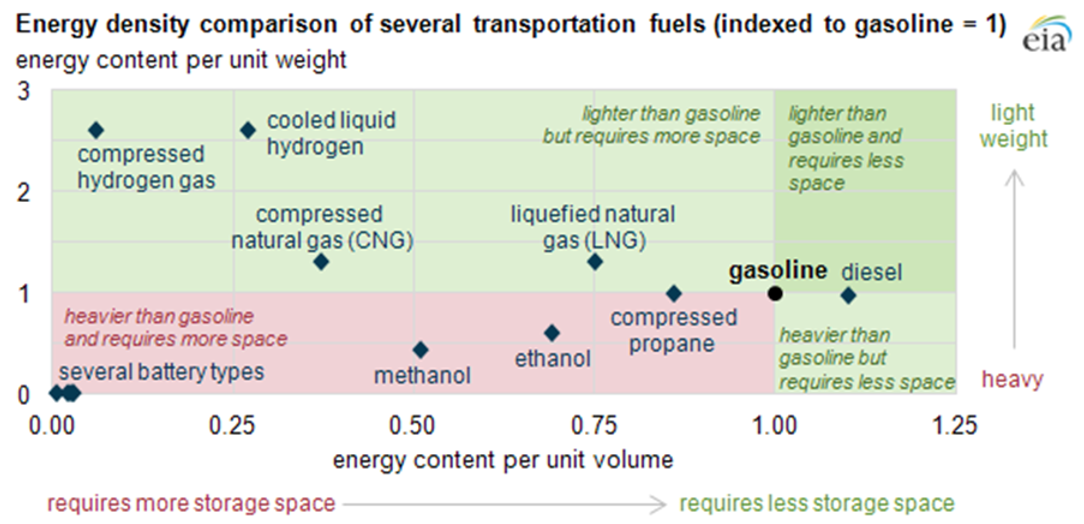
Relative energy density highlight the challenge of replacing oil or compressed natural gas as a fuel especially for transport without major advances in technology.
Electric vehicles (EVs) illustrate the problem. Vehicles must carry their fuel. As gasoline or diesel has very high energy density relative to the best current batteries, EVs are heavier than one running on fossil fuels. The mechanical simplicity and efficiency of electric motors cannot completely compensate for this weight penalty.
While this is not a substantial issue for passenger cars and light vehicles, for heavy transportation, such as long-haul trucking, shipping or aviation, this weight penalty is difficult to overcome. For example, 1 kilogram (2 pounds) of jet fuel contains 70 times as much energy as the best existing lithium-ion battery. In the case of airplanes, the weight of batteries required or the space needed to carry the hydrogen needed for longer flights would reduce payloads of passengers and freight altering economics.
The energy density advantages of fossil fuels is a factor in their EROEI (Energy Return on Energy Invested) potency relative to competing fuels. The lower energy density of renewables limits, in absence of major scientific breakthrough, its ability to replace existing fuels, especially for some applications. Historically, society has moved successively to sources with increasing energy density. Coal provided 50-100 percent more energy than the wood it replaced. Oil and gas provided 3-6 times more energy by weight than coal. The switch to renewables would reverse this trend.
Surface Power Density
Surface power density (sometimes shortened to power density), identified by Professor Vaclav Smil, measures the rate of energy production per unit of land area. It is generally calculated as the amount of power obtained per unit of earth surface used by the energy system, including all supporting infrastructure, manufacturing, mining of fuel (if applicable) and decommissioning. High surface power density signifies that larger amounts of power can be drawn from power sources occupying a relatively small area. Low surface power densities indicate that an equivalent energy output requires larger land areas.
The median surface power density of different energy sources are set out below.
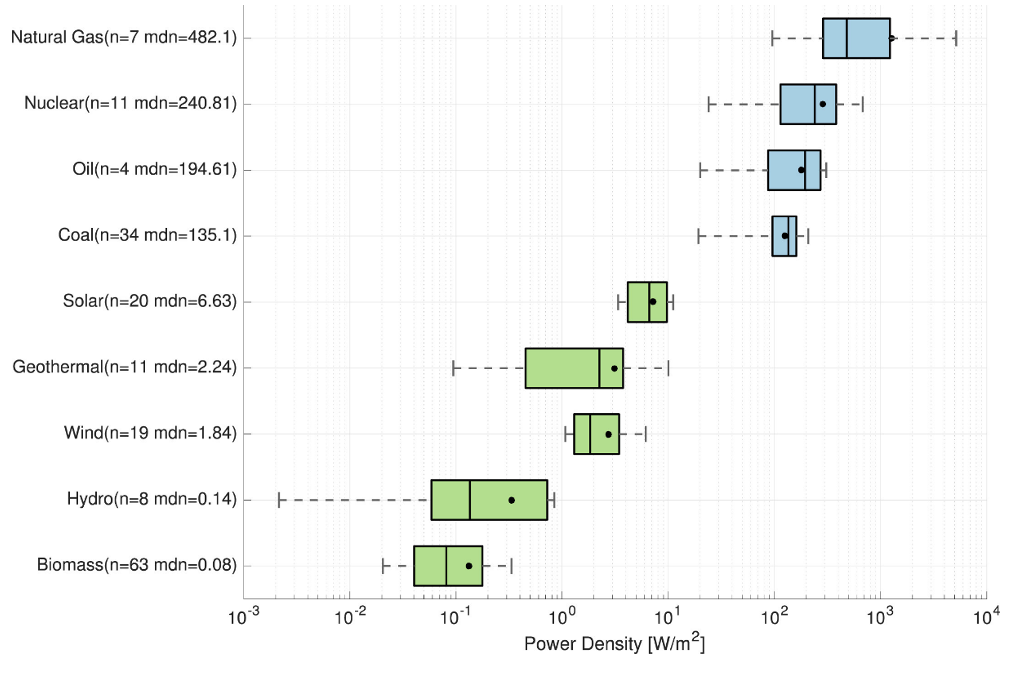
Fossil fuels and nuclear power have high power density. Renewable energy sources have power density several orders of magnitude smaller.
Solar and wind power require more area to be devoted to power generation. Modern coal or gas-fired power plants use roughly 121 hectares (300 acres) to generate 600 megawatts. This excludes the land areas needed for mining or extraction and transport. An equivalent wind farm would require over 20,000 hectares (50,000 acres). A solar array to provide similar amounts of power might require up to 2,400 hectares (6,000 acres). The coal or gas-fired plant would also have higher reliability supplying power almost 80-100 percent as against about 20-50 percent of the renewable option due to intermittency. To deliver the same power as UK Hinkley Point C nuclear plant – 3,200 million watts – it would require 5.5 million square metres of turbine swept area.
Bio-fuels illustrate the problem of low surface power density. The amount of corn needed to create sufficient ethanol to fill a 95-litre (25 gallon) SUV tank would feed an individual for a year. The grain needed to fuel all US cars is equivalent to an amount that could feed around 400 million people.
Lower surface power density creates potential conflicts over land use. Unless located in areas that have low population density or using land unsuitable for other applications, expansion of renewable energy clashes with needs of agriculture and human populations. This tension is evident in Germany where competing demands for land has proved a limitation in implementing the Energiewende, the ongoing transition by Germany to a low carbon, environmentally sound, reliable, and affordable energy supply based around renewables.
Characteristic Shortcomings
The existing energy system, developed over two centuries, entails accessing and transporting the fuel source, power generation as well as transmission and distribution. Users of energy are geared to prevailing energy types, especially for transportation and industrial applications. Pricing and trading structures are established and have been refined over time. Long term financing arrangements, often inflexible, are in place.
A shift to renewables requires a massive modification in the entire energy system as it currently exists. This would entail changes not only in sourcing power but in how this is used, including adjusting activities like heavy industry and mobility. The inherent characteristics of renewable energy sources – intermittency, infrastructure needs, density, surface density- have unfavourable effects on availability and cost of energy. These factors make them potentially unsuitable to substantially replace fossil fuels or nuclear power, as now frequently assumed, at least in the time scales thrown around.
As Josh Billing knew “as scarce as truth is, the supply has always been in excess of the demand”. The current debate around renewables is marred by a tendency to confuse what is with what we would like it to be. Faith in what we think is fact when unfortunately it is incorrect will not solve anything.


